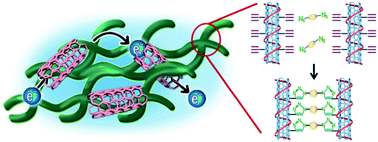Electrically conductive hydrogels are soft, polymeric networks that combine hydrogels’ unique properties with electroactive polymers’ inherent conductivity. With this in mind, Changsik Song and co-workers reported the design of single-walled carbon nanotubes (SWNTs) incorporated into polyvinyl alcohol (PVA) hydrogels by Cu-catalyzed azide–alkyne cycloaddition reaction. This efficient and modular reaction allowed the production of hydrogels with cross-linker molecules of various properties such as hydrophilic or hydrophobic character. Control of cross-linking density and molecular transport inside the click hydrogels was demonstrated by measuring degrees of swelling and the electrochemical diffusion coefficient of an ionic solute. In addition, incorporation of single-walled carbon nanotubes into the click hydrogels aided the growth of poly(3,4-ethylenedioxythiophene), presumably due to their enhancement of electrical conductivity. SWNT-incorporated PVA hydrogels synthesized by click chemistry may be of great interest for use as electrically conductive hydrogels in biomedical applications.
Synthesis of single-walled carbon nanotube-incorporated polymer hydrogels via click chemistry by Rebecca Eunji Lee, Jiyoung Park, Sung Gap Im and Changsik Song Polym. Chem. 2012, 3, 2451-2455.
To keep up-to-date with all the latest research, sign up for the journal’s e-alerts or RSS feeds or follow Polymer Chemistryon Twitter or Facebook.











